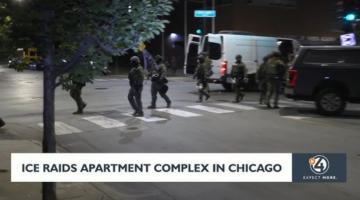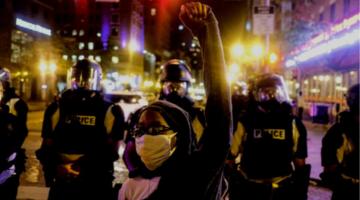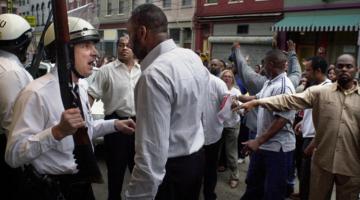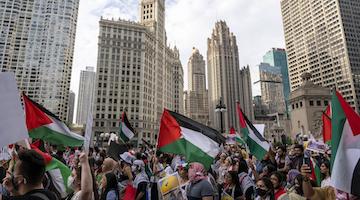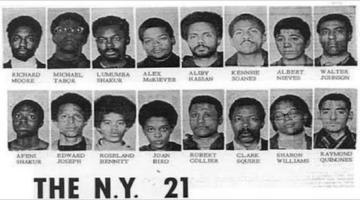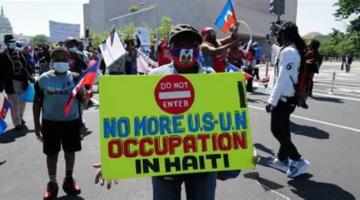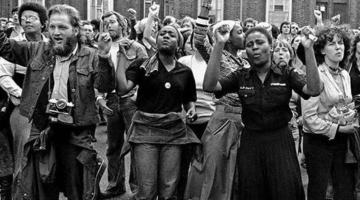It wasn't just Chicago Police operating Homan Square, the U.S. Department of Justice was equally involved in the workings of the "black site."
Originally published in Noir News .
Scandals don’t get much more disturbing than that of Homan Square. In 2015, the Guardian revealed Chicago Police had allegedly employed torture and days-long unlawful detention at the secretive “black site”-like Homan Square facility, a nondescript warehouse located in Chicago’s west-side Garfield Park neighborhood. Outraged and alarmed by these revelations, politicians and activists clamored for the U.S. Department of Justice to investigate human rights abuses at the facility, which still operates today.
Despite the pleading, the DOJ elected not to investigate Homan Square, and instead conducted a broad investigation of Chicago Police Department use of force practices.
The DOJ’s failure to specifically examine the alleged abuses at Homan left onlookers scratching their heads. Investigating the CPD’s use of force was important, of course, but why wouldn’t the DOJ also investigate the Homan Square facility given the severity of the allegations? One of the main figures pushing for a DOJ probe of Homan Square was then-Cook County Commissioner Richard Boykin, who sent letters to the Department asking them to investigate the facility. Asked whether he ever received an explanation as to why the DOJ didn’t investigate the facility, Boykin said: “I did not, which is surprising right?”
Noir News has examined an element of the Homan Square story that provides important context regarding the Department’s decision: the Department of Justice was inside of Homan Square all along, well aware of its use for extrajudicial detention, conducted its own interrogations in the facility, and is implicated in at least one of its most egregious abuse cases, that of Angel Perez.
Perez alleged CPD officers took him to Homan Square1 and pressured him to act as a cooperating witness in an investigation of alleged drug dealer Dwayne Payne. Namely, the officers wanted Perez to set up a drug purchase with Payne. Perez said he was taken to a room on the second floor of Homan Square and handcuffed to a bar and placed in ankle shackles for several hours. Officers allegedly threatened to plant evidence on Perez and send “him to the Cook County jail to be raped by gang members.”
After refusing to cooperate in the investigation, Perez alleges he was physically and verbally tortured by the officers for hours and that they refused to grant him access to a lawyer. One of the officers told Perez “‘I hear that a big black nigger dick feels like a gun up your ass.’” Then an officer “inserted a cold metal object, believed to be one of [the] officer’s service revolvers, into the plaintiff’s rectum causing the plaintiff severe pain and humiliation.” Finally, Perez relented and agreed to buy heroin from Payne for the officers.
Importantly, Perez’s lawsuit and the Guardian ’s reporting on it solely implicated the CPD. But as Noir News has discovered, a 2022 court order reveals the investigation that resulted in Perez’s detention and torture at Homan Square wasn’t just a CPD operation. Rather, the investigation of Payne was a “joint investigation with the USAO [United States Attorneys’ Office].” The United States Attorneys’ Office is an arm of the Department of Justice.
Payne was eventually charged alongside other defendants, as the DOJ announced in a 2013 press release that states the DOJ’s Drug Enforcement Administration (DEA) was also involved in the investigation.
If Perez’s allegations are true (and surveillance footage released by the Guardian indeed shows Perez being escorted into Homan through a door titled “Prisoner Entrance”), the DOJ built the case against Payne, in part at least, via torture. But even if Perez’s allegations are false, this case alone indicates the DOJ was aware of and implicated in the use of the Homan Square facility, where multiple other individuals reported being physically abused and illegally detained without access to an attorney. Moreover, the DOJ failed to disclose to the public its awareness of and involvement with Homan Square when activists and elected officials pressured the DOJ to investigate the facility.
“That’s terrible. That’s terrible,” Boykin said when Noir informed him that the DOJ was aware of Homan Square’s use as a detention facility and participated in the investigation that led to Perez’s detainment. “Then the DOJ failed the community. They failed the person who made the allegation. And they failed the country. They failed to do their job.”
Boykin said he had been under the impression the DOJ was unaware of Homan Square’s use as an off-the-books detention facility prior to the Guardian reporting.
The DOJ did not respond to inquiries asking for clarification about their operations in Homan Square. The CPD did not respond to specific inquiries about its operations in Homan Square, and did not comment on the DOJ’s use of the facility. Instead CPD responded with an unspecific denial: “These claims are unequivocally false. The Chicago Police Department's operations within all police facilities are rooted in lawful and constitutional policing. The Homan Square facility currently houses specialized units within the Bureau of Detectives and Bureau of Counterterrorism. It also houses the Evidence and Recovered Property Section, which is accessible to the public.” CPD did not respond to further inquiry.
Other aspects of the Perez case further demonstrate the DOJ’s knowledge of Homan Square. In a 2019 court order denying Perez’s “motion for class certification,” a U.S. District Judge wrote that federal law enforcement officers “regularly visited Homan Square” around the time of Perez’s detainment.
Perez is far from the only Homan Square detainee who has alleged mistreatment in the facility. As the Guardian reported, multiple detainees also alleged being: handcuffed for hours, kept in Homan Square for days with minimal food, punched and stepped on , threatened with a knife to the throat , and caged . Per the Guardian , at least 7,000 people were detained in Homan Square between August 2004 and June 2015, while “only 68 of those held were allowed access to attorneys or a public notice of their whereabouts.”
After the Guardian ’s initial reports, the news outlet filed a Freedom of Information Act request for CPD records of detention and interrogation at Homan Square, the denial of which led to a lawsuit by the outlet against the CPD to compel disclosure. In a November 2015 deposition taken for the lawsuit, the late CPD officer William Kilroy — a member of CPD’s Homan Square-headquartered narcotics unit — was asked questions about practices in Homan Square. While the Guardian cited parts of Kilroy’s deposition as evidence of Homan Square’s secretive nature and capacity to disappear detainees, his testimony regarding federal use of the facility has gone unreported.
Kilroy is asked about Homan Square interview rooms: “Are there ever situations where someone brings a camera into an interview room?”
Kilroy replied: “When we’re doing joint operations with the federal government, it’s generally — it’s under the supervision of an Assistant U.S. Attorney and they’re merely using our facility because it’s more convenient. They will set up their own audio-visual recording and they will conduct interviews that are part of a federal case but not part of anything that we take state.”
Kilroy Deposition
Additional evidence indicates the DOJ long knew of and exploited Homan Square’s use as an off-the-books holding facility unconstrained by constitutional protections. Beyond its role as a CPD “black site” as initially reported by the Guardian , Noir ’s findings reveal Homan Square served as a crucial nexus for major federal investigations into gang activity and drug trafficking.
The feds and CPD’s use of Homan Square as a detention facility hasn’t stopped. A Homeland Security special agent filed a criminal complaint in the U.S. District Court for the Northern District of Illinois describing how Jauan Brown was taken to Homan Square in October 2024 as part of a federal investigation.
In 2021, U.S. congressman Mike Quigley, who represents Illinois’ 5th congressional district (covering most of north-side Chicago), secured approval from the House Appropriations Committee for $500,000 in fiscal-year 2022 federal funding to “support the equipment to increase capacity, accuracy, and coordination of intelligence gathering with other law enforcement partners, including the FBI in particular,” and “support the Strategic Decision Support Centers (SDSC) that occur in districts with the goal of passing more intelligence to aid enterprise investigations at Homan Square and inform command staff via Crime Prevention and Information Center (CPIC).” Representative Quigley’s funding request, which specifically mentions supporting “enterprise investigations at Homan Square,” was put forth several years after the alleged abuses at Homan Square first came to light, and after years of calls from activists and politicians to close the facility.
Representative Quigley could not be reached for comment.
Other Cases
A 2017 court order upholding the jury verdict convicting several members of the crime ring “The Hobos,” reveals an FBI agent, Bryant Hill, interrogated a suspect in the Homan Square facility on October 22, 2008. Per the order, one of the defendants, Gregory Chester, “contends that this Court erred by allowing the government to present evidence of his statements to police on the night he was seized along with Walter Binion and interviewed at the Homan Square police station. He contends that his statement was fruit of an illegal seizure and therefore should have been suppressed. This Court denied Chester’s motion to suppress the statement, after a full hearing at which Chester testified, as did (then) Sergeant James Sanchez of the Chicago Police Department and Special Agent Bryant Hill of the FBI.”
Chester was brought to Homan and interrogated, according to the order. While detained, Chester “said he told the FBI (Agent Bryant Hill) that ‘I don’t know nothing about no Hobos, no robberies, no shootings, no murders, no nothing.’”
Whatever Chester actually said to Agent Hill, the 2017 court order shows that an FBI agent interrogated Chester at Homan Square. This is further evidenced by an appeals court opinion which states that: “Before trial, Chester moved to suppress his October 22 statements, arguing that they were the result of an illegal detention that was not supported by probable cause… Officer Sanchez testified about the stop, and both Sanchez and Agent Hill testified about the interview that followed.”
The case of United States v. Chaparro , in which Johnny Chaparro and Johnny Mendez “were charged with conspiracy to possess with intent to distribute and conspiracy to distribute large quantities of cocaine and heroin,” stemmed from an “extensive investigation by the Chicago Police Department (‘CPD’), the Drug Enforcement Administration (‘DEA’), and the U.S Attorney’s Office.”
A 2014 court order in the case describes how, on November 29, 2012, after CPD officers questioned Chaparro and Mendez at Mendez’s residence, an officer identified as Lt. Cline “felt that a change of venue would impress the gravity of the situation upon Mendez… Accordingly, Lt. Cline ordered the other officers to arrest and relocate Mendez and Chaparro to the Homan Square police station so that they could be interviewed there.”
The joint nature of the investigation likely means that the Department of Justice was well-aware of the use of Homan Square for detainment and interrogation during the course of the investigation itself. The opinion also states that Lt. Cline had “continuous contact with the U.S. Attorney” throughout the investigation. But even if Cline or other CPD officers failed to inform the Department of Justice about the use of Homan Square, the court opinion outlining this course of events was written in 2014, months before the Guardian first wrote about the facility.
Federal agents’ knowledge and use of Homan Square is further demonstrated in the case of United States v. Xavier Elizondo & David Salgado, which centered on CPD officers Elizondo and Salgado’s use of their positions to embezzle money and drugs. The 2021 appeals court opinion upholding the officers’ convictions describes how, as part of the FBI’s investigation into Elizondo and Salgado, federal agents planted a vehicle containing $18,200, and had a confidential informant tell the two officers “that a drug dealer was storing drugs and cash in a vehicle near Midway Airport.” Elizondo and Salgado traveled to the vehicle, removed the cash planted inside by the FBI, and ultimately only inventoried $14,000 of the $18,200. The court opinion describes how the next day, “CPD Internal Affairs Lieutenant Timothy Moore—who was detailed as an FBI task force officer—and FBI Special Agent Robert Leary went to CPD’s Homan Square facility to recover the inventoried $14,000 and the rental vehicle used in the previous night’s operation.”
The 2008 case United States of America v. Francisco Mendez-Nunez, et al. , is described in a court document as stemming from an investigation that included the participation of “agents from various federal agencies [including the FBI], as well as officers from the Chicago Police Department.”
Meghan C. Morrissey, an Assistant United States Attorney for the Northern District of Illinois, wrote that, following the execution of a search warrant during the investigation, DEA Special Agent Dick Mah “transported all of the recovered evidence to the Chicago Police Department’s Homan Square facility, where he turned it over to DEA Special Agents James Walsh and John Kennelly for processing.” The document suggests the DEA not only visited Homan Square and was aware of the operations within it, but also that the agency itself has used the facility in the course of some investigations as a base of operations.
A court document likewise describes U.S. v. Van Sach as stemming from a Bureau of Alcohol, Tobacco, Firearms and Explosives (ATF) investigation. The document, dated August 16, 2006, states that a “CI [Confidential Informant], ATF agents, and task force officers from the High Intensity Drug Trafficking Area Unit met at Homan Square, which was near Van Sach’s [the defendant’s] house, to plan the operation” in which the Confidential Informant would purchase a firearm from the defendant. The ATF agents and the Confidential Informant returned to Homan Square following the successful operation. Thus, the ATF, another arm of the DOJ, has used Homan Square in a similar manner to the DEA.
More on the ATF: a little-noticed paragraph at the end of a September 2020 Patch news article states that firearms seized in an Evanston police traffic stop were brought “to the Bureau of Alcohol, Tobacco, Firearms and Explosives offices at the Chicago Police Department’s Homan Square facility for test firing. ATF staff told police that results of the testing would be available within 24 hours, police reported.”
Noir could not verify the existence of an ATF office in Homan Square by the time of publication.
It’s likely, if not guaranteed, that the DOJ has conducted other interrogations at Homan Square and that it had even more intimate knowledge of practices at the facility than is indicated by these court cases.
Corruption Investigation
From 2006 to 2012, the FBI conducted an investigation of corrupt officers assigned to the CPD’s narcotics unit, Unit 189, headquartered in Homan Square. The FBI recruited two Unit 189 officers to work for the bureau undercover, Shannon Spalding and Danny Echeverria.
Spalding and Echeverria’s investigation and willingness to blow the whistle was widely-celebrated by a number of media outlets.
However, the positive coverage of these whistleblowers missed the implications of these officers’ undercover work for the FBI. Two members of Unit 189, the narcotics unit alleged to have committed so many of the abuses in Homan Square, were working undercover with the FBI throughout 2006-2012. This likely means the FBI had intimate knowledge of the inner workings of Homan Square, and that two of its undercover assets were participating in — or at the very least had knowledge of — the detentions and interrogations at the facility.
Aside from the implications these facts have regarding the DOJ’s complicity in alleged abuses at Homan Square, they may also reveal an interesting dynamic in Chicago politics. During his campaign, Mayor Brandon Johnson promised to shutter Homan Square. The author of the original exposés on Homan Square, Spencer Ackerman, publicly pleaded for Johnson to do just that.
Given the feds’ use of the facility, the mayor of the City of Broad Shoulders wouldn’t just be contending with the forces of Chicago politics if he wanted to close down the facility. He’d be tangling with the DOJ.
“Ultimately we hope we get justice and we hope that those abuses aren’t taking place today. At Homan, or at any police facility,” Boykin said.
1 Angel Perez originally believed he was taken to a different police station.
Iain Carlos is a journalist covering power, vice and faith.
Sam Carlen is an analyst at an economic consulting firm. Find his writing at noirnews.org & irrationalactor.com

